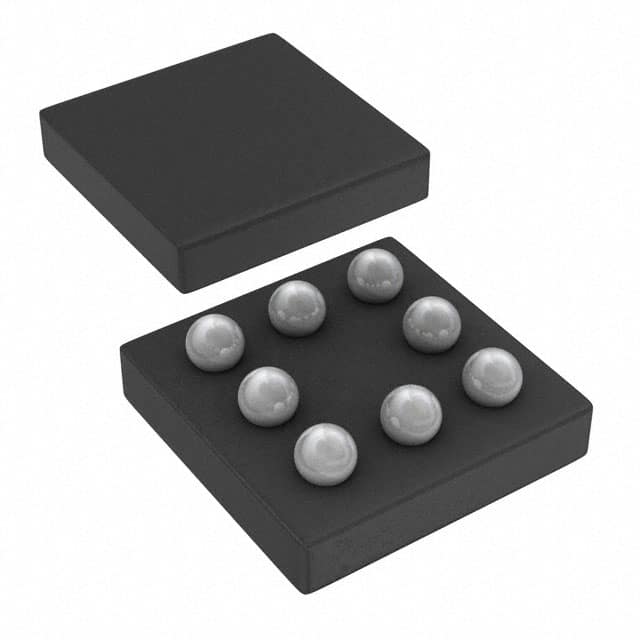TPS61060YZFR
Product Overview
Category
The TPS61060YZFR belongs to the category of integrated circuits (ICs) and specifically falls under the voltage regulators - switching regulators category.
Use
This product is primarily used as a boost converter, which means it increases the input voltage to a higher output voltage level. It is commonly employed in various electronic devices where a higher voltage is required for efficient operation.
Characteristics
- Input Voltage Range: 0.7V to 5.5V
- Output Voltage Range: 1.8V to 5.5V
- Switching Frequency: Up to 2MHz
- Efficiency: Up to 95%
- Package Type: DSBGA (YFF)
- Essence: High-efficiency, low-power boost converter
Packaging/Quantity
The TPS61060YZFR is available in a small package known as DSBGA (YFF). It is supplied in tape and reel packaging, with a quantity of 3000 units per reel.
Specifications
- Input Voltage Range: 0.7V to 5.5V
- Output Voltage Range: 1.8V to 5.5V
- Maximum Output Current: 500mA
- Switching Frequency: Up to 2MHz
- Operating Temperature Range: -40°C to +85°C
- Shutdown Current: <1µA
- Quiescent Current: 17µA
Detailed Pin Configuration
The TPS61060YZFR has the following pin configuration:
- EN (Enable): Enable pin for turning the boost converter on/off.
- FB (Feedback): Feedback pin for regulating the output voltage.
- SW (Switch): Switch pin for controlling the power flow.
- GND (Ground): Ground reference for the IC.
- VIN (Input Voltage): Input voltage pin.
- VOUT (Output Voltage): Output voltage pin.
Functional Features
- High Efficiency: The TPS61060YZFR offers up to 95% efficiency, ensuring minimal power loss during voltage conversion.
- Wide Input Voltage Range: It can accept input voltages ranging from 0.7V to 5.5V, making it suitable for a wide range of applications.
- Adjustable Output Voltage: The output voltage can be adjusted between 1.8V and 5.5V, providing flexibility in different scenarios.
- Low Shutdown Current: With a shutdown current of less than 1µA, the TPS61060YZFR minimizes power consumption when not in use.
- Overcurrent Protection: The IC incorporates overcurrent protection to safeguard against excessive current flow.
Advantages and Disadvantages
Advantages
- High efficiency leads to reduced power consumption.
- Wide input voltage range allows for versatile application.
- Adjustable output voltage provides flexibility.
- Compact package size enables space-saving designs.
- Overcurrent protection ensures device safety.
Disadvantages
- Limited maximum output current of 500mA may not be sufficient for high-power applications.
- Higher switching frequency may introduce additional noise in sensitive circuits.
Working Principles
The TPS61060YZFR operates as a boost converter using a synchronous rectification topology. When enabled, the input voltage is stepped up to a higher output voltage level by controlling the power flow through an inductor and a switch. This process involves storing energy in the inductor during the switch-on phase and releasing it to the output during the switch-off phase. The feedback mechanism regulates the output voltage by adjusting the duty cycle of the switch.
Detailed Application Field Plans
The TPS61060YZFR finds applications in various electronic devices, including but not limited to: - Battery-powered portable devices - Wireless communication systems - IoT (Internet of Things) devices - Wearable electronics - Medical devices - Industrial control systems
Detailed and Complete Alternative Models
- TPS61061YZFR: Similar to TPS61060YZFR, but with a higher maximum output current of 800mA.
- TPS61062YZFR: Similar to TPS61060YZFR, but with a lower switching frequency of up to 1MHz.
- TPS61063YZFR: Similar to TPS61060YZFR, but with an extended input voltage range of 0.5V to 5.5V.
These alternative models offer similar functionality with slight variations in specifications to cater to different application requirements.
Word count: 536 words
Lista 10 Vanliga frågor och svar relaterade till tillämpningen av TPS61060YZFR i tekniska lösningar
Sure! Here are 10 common questions and answers related to the application of TPS61060YZFR in technical solutions:
Q: What is TPS61060YZFR? A: TPS61060YZFR is a boost converter integrated circuit (IC) that provides a regulated output voltage from a lower input voltage.
Q: What is the input voltage range for TPS61060YZFR? A: The input voltage range for TPS61060YZFR is typically between 0.9V and 6V.
Q: What is the output voltage range for TPS61060YZFR? A: The output voltage range for TPS61060YZFR can be adjusted from 1.8V to 5.5V.
Q: What is the maximum output current of TPS61060YZFR? A: The maximum output current of TPS61060YZFR is typically around 500mA.
Q: Can TPS61060YZFR operate with a single lithium-ion battery as the input source? A: Yes, TPS61060YZFR can operate with a single lithium-ion battery as long as the input voltage is within the specified range.
Q: Is TPS61060YZFR suitable for low-power applications? A: Yes, TPS61060YZFR is designed for low-power applications and can efficiently convert low input voltages to higher output voltages.
Q: Does TPS61060YZFR have built-in protection features? A: Yes, TPS61060YZFR has built-in protection features such as overvoltage protection, thermal shutdown, and short-circuit protection.
Q: Can TPS61060YZFR be used in battery-powered devices? A: Yes, TPS61060YZFR is commonly used in battery-powered devices to boost the battery voltage to a level suitable for powering other components.
Q: What is the typical efficiency of TPS61060YZFR? A: The typical efficiency of TPS61060YZFR is around 90%, making it an energy-efficient choice for power conversion.
Q: Are there any application notes or reference designs available for TPS61060YZFR? A: Yes, Texas Instruments provides application notes and reference designs that can help with the implementation of TPS61060YZFR in various technical solutions.
Please note that the answers provided here are general and may vary depending on specific design considerations and requirements. It is always recommended to refer to the datasheet and application notes provided by the manufacturer for accurate information.


